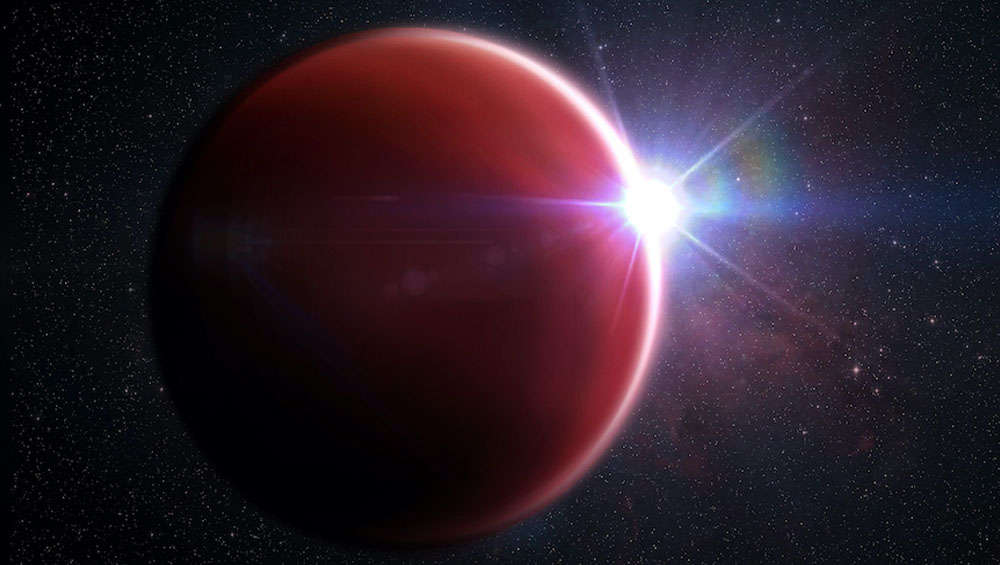Create a free profile to get unlimited access to exclusive videos, sweepstakes, and more!
Space forecast is clear skies, because a Jupiter-like gas giant with no upper atmosphere clouds exists

Swirls of clouds and haze on Jupiter and Saturn have become so iconic, that look has become a thing for all gas giants, to the point that you even see it on planet emojis. But you know what they say about stereotypes.
Exoplanet WASP-62b is a hot Jupiter that is also the first Jupiter-like planet to have no clouds or haze — at least in its upper atmosphere. It was found by the Wide Angle Search for Planets (WASP) survey, but never really paid attention to until now. There are few planets which have a perpetual forecast for clear skies. No cloudless planets like Jupiter, hot or not, have ever been known to exist before. The only other similar gas giant known to exist is hot Saturn WASP-96b.
Munazza Alam, a grad student at the Harvard Center for Astrophysics, was trying to characterize this weird planet’s atmosphere for her thesis when she realized something unexpected was going on. There was chemical evidence surfacing that would have not shown up if it had been obscured by clouds or haze.
“We don't know why cloudless planets are so rare,” Alam, who recently led a study published in The Astrophysical Journal Letters, told SYFY WIRE. “The majority of Solar System bodies with atmospheres have clouds, so this just may be a natural atmospheric process. But we still don't fully understand the processes that govern or determine cloud formation. This is a key open question in our understanding of exoplanet atmospheres.”
Hot Jupiters are gas giants that orbit close enough to their host stars to have scorching temperatures and short orbital periods (less than 10 days, compared to Jupiter’s 12 years). There are already enough mysteries surrounding how they are born. Another thing that keeps confusing scientists is how these planets end up getting into an orbit so close to their stars when they are way too huge to have formed where they orbit. Studying a planet like WASP-62b, the first known hot Jupiter of its kind, could give us an idea of how they form and make it much easier to see through to their chemical compositions at what else might be inside.
Finding out what is in the atmosphere of a hot Jupiter involves using spectroscopy. Gases and chemicals in the atmosphere can be detected when one of these planets transits its star, and the spectrum of starlight that makes it through that atmosphere is then analyzed. Alam used Hubble data and observations to get a closer look at WASP-62b through three transits. By making visible light observations, which help find sodium and potassium in a planet’s atmosphere, it became evident that she was seeing through something.
“When we say that WASP-62b is a cloudless planet, we mean to say that the planet is cloudless at the levels of the planet's atmosphere that we are capable of probing through for our observations,” Alam said. “It is unphysical to think of a planet with an atmosphere as completely cloudless, so it's likely that any clouds on WASP-62b are much deeper in the atmosphere where we can't observe.”
She was able to make out the entire absorption line of sodium on the planet. This would have been impossible to see with anything in the way, which told her that she was looking at a planet with no clouds or haze in its upper atmosphere. It was hard to believe when gas giants are expected to have these features because their gases condense into clouds while their chemistry produces hazes. The nearly opaque clouds in some hot Jupiter atmospheres have actually prevented some studies from going further. Had there been either of those obscuring factors, such a clear view of the sodium in this planet’s lower atmosphere would have not surfaced.
“The sodium signal gave away the cloudless nature of this planet because we were able to observe the full absorption line,” Alam said. “Sodium is readily observable in exoplanet atmospheres in the optical wavelength range. In a chemical sense, this element plays an interesting, yet not well-understood, role in the atmospheric physics and chemistry of giant planets.”
If more is found out about what lies in the gaseous depths of WASP-62b, this hot Jupiter might even give us an idea of what is hiding beneath the clouds of our own Jupiter.















